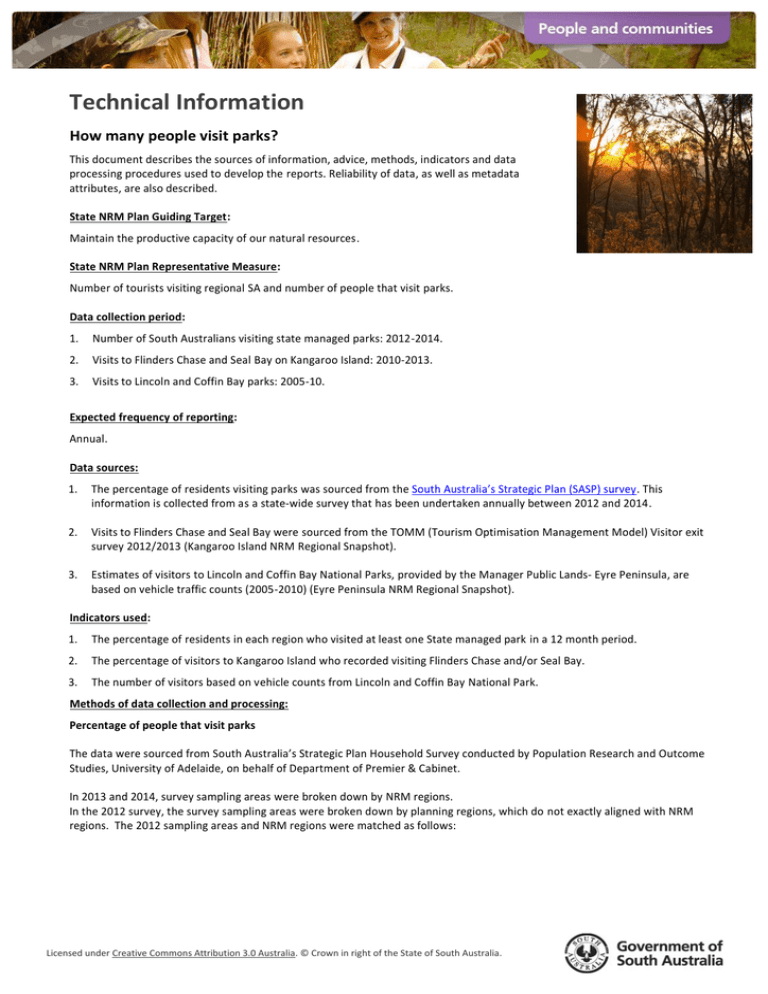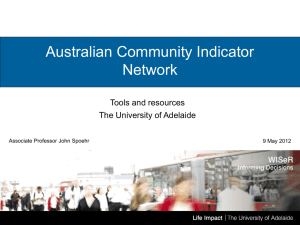Technical Information
advertisement

Technical Information How many people visit parks? This document describes the sources of information, advice, methods, indicators and data processing procedures used to develop the reports. Reliability of data, as well as metadata attributes, are also described. State NRM Plan Guiding Target: Maintain the productive capacity of our natural resources. State NRM Plan Representative Measure: Number of tourists visiting regional SA and number of people that visit parks. Data collection period: 1. Number of South Australians visiting state managed parks: 2012-2014. 2. Visits to Flinders Chase and Seal Bay on Kangaroo Island: 2010-2013. 3. Visits to Lincoln and Coffin Bay parks: 2005-10. Expected frequency of reporting: Annual. Data sources: 1. The percentage of residents visiting parks was sourced from the South Australia’s Strategic Plan (SASP) survey. This information is collected from as a state-wide survey that has been undertaken annually between 2012 and 2014. 2. Visits to Flinders Chase and Seal Bay were sourced from the TOMM (Tourism Optimisation Management Model) Visitor exit survey 2012/2013 (Kangaroo Island NRM Regional Snapshot). 3. Estimates of visitors to Lincoln and Coffin Bay National Parks, provided by the Manager Public Lands- Eyre Peninsula, are based on vehicle traffic counts (2005-2010) (Eyre Peninsula NRM Regional Snapshot). Indicators used: 1. The percentage of residents in each region who visited at least one State managed park in a 12 month period. 2. The percentage of visitors to Kangaroo Island who recorded visiting Flinders Chase and/or Seal Bay. 3. The number of visitors based on vehicle counts from Lincoln and Coffin Bay National Park. Methods of data collection and processing: Percentage of people that visit parks The data were sourced from South Australia’s Strategic Plan Household Survey conducted by Population Research and Outcome Studies, University of Adelaide, on behalf of Department of Premier & Cabinet. In 2013 and 2014, survey sampling areas were broken down by NRM regions. In the 2012 survey, the survey sampling areas were broken down by planning regions, which do not exactly aligned with NRM regions. The 2012 sampling areas and NRM regions were matched as follows: Licensed under Creative Commons Attribution 3.0 Australia. © Crown in right of the State of South Australia. 2012 Survey sampling area Eastern Adelaide Northern Adelaide Southern Adelaide Western Adelaide Adelaide Hills Barossa Fleurieu and Kangaroo Island Eyre and Western Far North Limestone Coast Murray and Mallee Yorke and Mid North Broadly aligned NRM region Adelaide and Mount Lofty Ranges Adelaide and Mount Lofty Ranges Adelaide and Mount Lofty Ranges Adelaide and Mount Lofty Ranges Adelaide and Mount Lofty Ranges Adelaide and Mount Lofty Ranges Adelaide and Mount Lofty Ranges and Kangaroo Island Eyre Peninsula SA Arid Lands and Alinytjara Wilurara South East SA Murray-Darling Basin Northern and Yorke Because the Adelaide and Mount Lofty Ranges and Kangaroo Island NRM regions and the SA Arid Lands and Alinytjara Wilurara NRM regions overlap in the break down of the 2012 results, only two year trends (2013-14, e.g. the years that the data is broken down by NRM region) have been calculated for these regions in the Regional Snapshot cards. The 2012 data that best aligns with the NRM region has been provided for context in the Regional Snapshot trend graphs. For example, in the Kangaroo Island NRM regional snapshot, the 2012 data for Fleurieu and Kangaroo Island is presented but not included in the trend calculation. The number of people that were surveyed each year is summarised below: Number of people surveyed 2013 NRM region 2012 2014 Adelaide and Mount Lofty Ranges and Kangaroo 3515 Island Eyre Peninsula 522 SA Arid Lands and Alinytjara Wilurara 470 South East 498 SA Murray-Darling Basin 505 Northern and Yorke 514 State Total 6000 2000 1940 The number of people surveyed in each region were broadly representative of the population in each region. Note, no breakdown by NRM region are available for 2013 and 2014. Trends were analysed as the percentage of change per year over the three year period for which data were available. Trends were classified as stable (less than 5% overall change), increasing/‘Getting better’ (greater than +5% change) or decreasing/’Getting worse’ (less than -5% change). As noted above, the differences in how sampling was broken down in the 2012 dataset to the following years may impact the trend results. As such, trends for the Adelaide and Mount Lofty, Kangaroo Island, SA Arid Lands and Alinytjara Wilurara NRM regions only use 2 years of data. Because trends could not be determined with just 2 years of data, their trends have been recorded as ‘stable’. Future reporting measures: Future reporting could include information that is collected from gate fees and vehicle counters. However, this information is only available for some of the most visited parks and cannot readily be extrapolated to all parks in a region or the State. This information will be investigated in the future to assess its usefulness. The following government agencies contributed to this report: DEWNR. The following non-government agencies contributed to this report: None. Key stakeholders: Licensed under Creative Commons Attribution 3.0 Australia. © Crown in right of the State of South Australia. Park managers, State and regional tourism industry managers and investors. Information reliability scoring: Information is scored for reliability based on average scores given for information currency and applicability, and its level of spatial representation (Tables 1–3). Table 1. Information currency Reliability 5 4 3 2 1 Criteria Information up to 3 years old Information up to 5 years old Information up to 7 years old Information up to 10 years old Information >10 years old Table 2. Applicability of the information Reliability 5 4 3 2 1 Criteria All data based on direct indicators of the measure Most data based on direct indicators of the measure Most data based on indirect indicators of the measure All data based on indirect indicators of the measure Data are based on expert opinion of the measure Table 3. Spatial representation of information (sampling design) Reliability 5 4 3 2 1 Criteria Information is collected from across the whole region/state (or whole distribution of asset within the region/state) using a stratified sampling design Information is collected from across the whole region/state (or whole distribution of asset within the region/state) using a sampling design that is not stratified Information is collected from an area that represents less than half the spatial distribution of the asset within the region/state Information is collected from an area that represents less than 25% the spatial distribution of the asset within the region/state Information is collected from an area that represents less than 5% the spatial distribution of the asset within the region/state or spatial representation unknown Based on tables 1, 2 & 3 above, respectively, the information relating to number of visits to regional SA presented in this report has a reliability score of (5+1+1)/3 = 2.33 rounded to 2 (Fair). This report is linked to the following report cards/snapshots: 1. How many people visit regional South Australia? 2. How many volunteers are involved in natural resource management? Metadata description: Project/Dataset Name: Number people visiting parks Abstract/description The South Australia’s Strategic Plan Household Survey included responses from across SA in from 2012-14. It determined the proportion of people from each region who visit State managed parks. Data types Numerical data from questionnaire surveys of people. Licensed under Creative Commons Attribution 3.0 Australia. © Crown in right of the State of South Australia. Organisation/ DEWNR business area that sponsors/holds/manages the data Survey conducted by Population Research and Outcome Studies, University of Adelaide, on behalf of Department of Premier & Cabinet (DPC). DPC owns the data. Date Range 2012-14 (people were asked about their behaviour over a 12 month period) Study Area All of South Australia (broken down into regions) Data format Excel Data distribution rules Licensed under Creative Commons Attribution 3.0 Australia Is the dataset source data (raw), value-add data (analysed/summarised) or final indicator/score data? Value-add Photo credit details: AMLR and State Photo Title: Cleland-284 (Cleland Conservation Park) AW title: DENR 1120 (Far West Coast) EP title: bjd_EP_09_07_0845_wpa-coast-063 (Memory Cove Wilderness Protection Area) KI title: sealbay (Seal Bay Conservation Park) NY title: bjd jan-09 innes np 177 emus (Emus at Innes National Park) SAAL title: IMGP1177 (Flinders Ranges National Park) SAMDB: Murraymout(1) (Coorong National Park) SE title: bjd-naracoorte WHA – i Alexandra – bf (Naracoorte Caves National Park) Owner: DEWNR Scientific literature referred to in the report: Putrill, J. 2013, ‘Our national parks prove a marketer’s nightmare’, Weekend Australian, 27 April, pp.15-18. Muñoz, S.A. (2009) Children in the Outdoors a literature review. Sustainable Development Research Centre, Horizon Scotland. Nature Play Inc. (2014) Nature Play SA getting our kids outdoors. Website accessed November 2014. Population Research and Outcome Studies (2012) South Australia’s Strategic Plan (SASP) survey. Report prepared for the Department of Premier and Cabinet. The University of Adelaide, South Australia. Colmar Brunton, TOMM Kangaroo Island committee. Visitor exit survey 2012/13. September 2013. Prepared for the TOMM committee Kangaroo Island by Colmar Brunton. Licensed under Creative Commons Attribution 3.0 Australia. © Crown in right of the State of South Australia.


